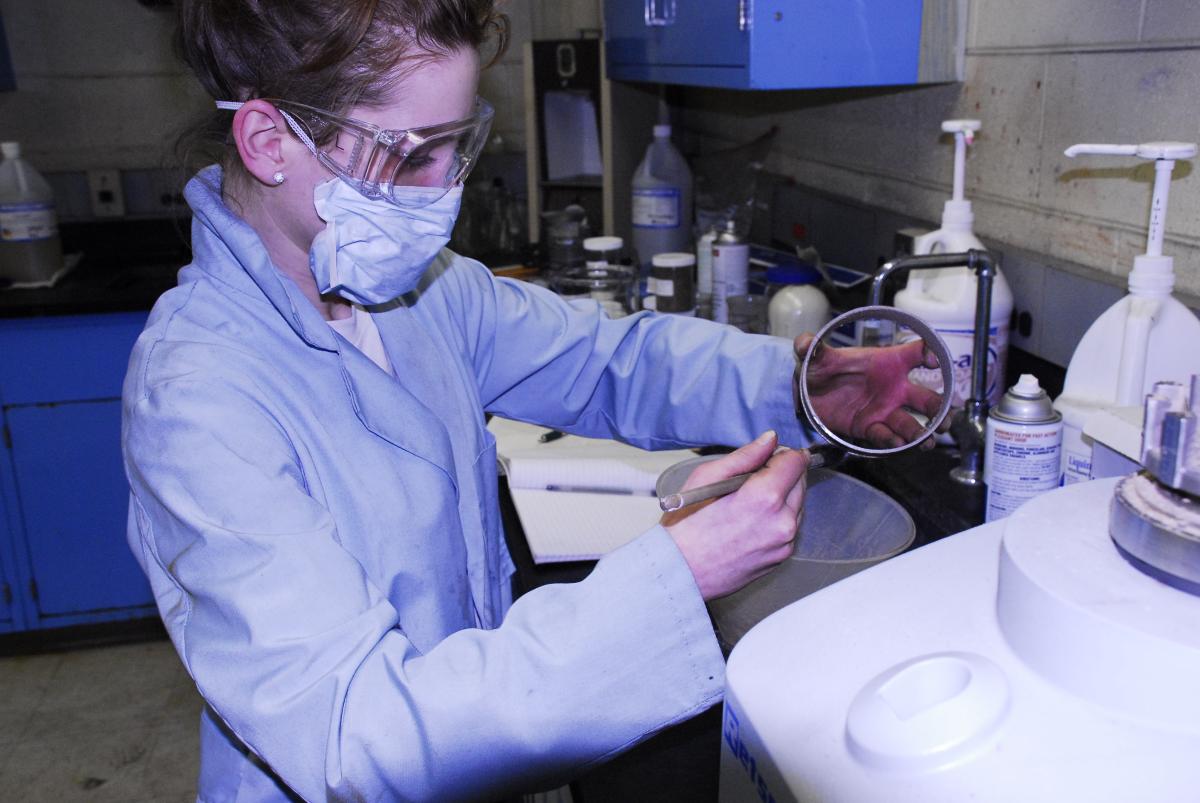Student learns more than science in the Energy Institute lab
By Shea Winton
On the last day of the semester Natalie Keener (’11 B.S. Energy Engineering) along with her teammates from a recent project stopped by the EMS Energy Institute to thank the research staff and pose for photos. (The project won an award detailed here.) The only woman in the group, Keener posed with her teammates, holding up the award they received for their accomplishments, her cheerful demeanor showing in her smile.
 While Keener’s excitement about the prospect of starting a career was obvious, it was also apparent that she appreciated her experiences in the EMS Energy Institute as well as the faculty and staff who worked with her. In talking about her experiences, she made sure to mention specific people who were especially important to her accomplishments.
While Keener’s excitement about the prospect of starting a career was obvious, it was also apparent that she appreciated her experiences in the EMS Energy Institute as well as the faculty and staff who worked with her. In talking about her experiences, she made sure to mention specific people who were especially important to her accomplishments.
“I am very thankful for my experience at the Institute, and I look forward to giving back in the future,” Keener said.
Some of those experiences have very little to do with energy. Keener found out that lab work offered learning opportunities beyond a science textbook. She noted that her research at the Institute gave her a better understanding about the importance of project planning, time management, communication and coordination, which she sees as an advantage for future leadership roles.
She acknowledged that the biggest takeaway from working on projects at the Institute was workplace communication and accountability. Although, true to the nature of lab work, she was given a lot of freedom when it came to work hours and deadlines, she made it a point to hold herself accountable for specific tasks. In addition, research projects are often collaborative and her work was no different. So good communication and coordination with team members, Institute staff, outside company contacts, and supervisors was imperative to getting her work done.
Much of Keener’s time at the Institute was spent working on a Biomass Combustion Properties Database for the Electric Power Research Institute (EPRI) with her supervisor Bruce Miller, senior scientist and associate director of the EMS Energy Institute. Keener collected biomass information and analysis; classified the biomass as woody, herbaceous, or processed biomass; and added them to the database, which she helped develop.
This project coincided with a course she was taking, Biomass Energy Systems (ABE 497B), and offered a learning opportunity she might not have had otherwise.
“Although some of the data I was working on was a bit daunting in the beginning, the content of this course helped me understand more of the combustion properties,” Keener said. “Because I was able to make it a learning experience, I enjoyed it very much.”
In part because of this greater understanding, Keener opted to continue biomass research through the Spring 2011 semester. Under the supervision of Sharon Falcone Miller, reserach associate at the EMS Energy Institute, Keener performed biomass torrefaction and grinding studies as part of her senior resarch project course (EGEE 494A) and independent study (EGEE 496). She also trained a new hire to continue her work on the EPRI database when her schedule got too busy. In December 2010, the Institute recognized Keener for her service to the research, service, and educational missions of the Institute (page 25).
In addition to the biomass projects, Keener worked at the Institute on a group Capstone Design project for EGEE 464W, advised by André Boehman, professor of fuel science. Members of the team, which was awarded best project at the Lockheed Martin Design Awards, included Natalie Keener, Adam Kimmerle, Liam O’Sullivan, Timothy Tomko, and Shaun Valentine. The team designed and built a hydrocyclone enhanced with a four-pole AC electromagnet pulsing in the direction of the hydrocyclone flow to improve the industry method of recovering magnetite once it has been used in a slurry mix to separate mineral matter from coal.
In addition to classes and research, Keener was also the president of The Society of Energy Engineers, which began in Fall 2009 to increase the awareness and involvement of energy engineers in professional activities. While president, she coordinated group activities for energy engineers to learn about existing energy technologies and discover new ones. Some of the events members participated in included the 2010 PA Renewable Energy Festival, 2011 Mid Atlantic Region Wind Energy Conference, and Braezeale Nuclear Reactor tours. In addition, industry professionals came to talk to the group.
“It was a great opportunity to connect energy engineers, find strengths among them, and use those strengths to gain more awareness and respect for the major,” Keener said.
Currently Keener’s focus is on finding a full-time position as an energy or environmental services consultant. She wants to practice her knowledge of energy technology while enabling the average person to be more efficient with what they have.
“I want to become a leader in energy efficiency awareness, teaching, and practice,” Keener said when asked about her career goal.
She explained that while companies can hire a consultant to change systems, reduce energy input, and decrease costs, a lot of efficiency gain can be made every day through individual choices.
“I went into Energy Engineering for the prospect of increasing efficiency and reducing environmental impact, and this is the effect I would like to have in my career,” Keener said.

